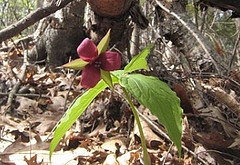 (Host) The first Earth Day was celebrated 40 years ago today.
(Host) The first Earth Day was celebrated 40 years ago today.
That was before the Environmental Protection Agency existed.
Before the Clean Water, Clean Air and Endangered Species Acts were passed. And well before concerns over global warming.
Despite the changes humans have inflicted on the planet, some things on Earth have pretty much remained the same.
As part of a collaboration with Northeast public radio stations, we have two audio postcards in celebration of Earth Day, beginning with Nancy Cohen from WNPR in Hartford.
(Cohen) Les Mehrhoff is walking up the backside of a trap rock ridge in Connecticut called Talcott Mountain. Mehrhoff, a professor at U Conn, became a professional botanist not long after the first Earth Day in 1970. Despite his years in the field he remains effervescent around native plants.
(Mehrhoff) "That’s a Red Trillium. Have you ever seen Red Trilliums?"
(Cohen) If you haven’t, get out in the woods and look for a plant with a whorl of three onion-shaped leaves below a showy maroon flower. But the exquisite Red Trillium is also known as "Stinking Benjamin."
(Mehrhoff) "When you take a sniff of it. It smells like rotting meat. Don’t forget the flower color is not there for our enjoyment. We enjoy it! But its real function is to attract pollinators into the reproductive parts to ensure the plant gets a chance to reproduce itself by producing seeds. This is pollinated by flies that are attracted to rotting meat."
(Cohen) The Red Trillium is heading up a parade of spring ephemerals, the short-lived early spring flowers.
(Mehrhoff) "Oh! Look over here!"
(Cohen) Mehrhoff points to clusters of white petals on a plant called Early Saxifrage.
(Mehrhoff) "You find it in these sort of drier areas or on rock outcrops like this: small basal leaves, a hairy stock and lots of white flowers, early in the spring. Look! Look at the garter snake! Oh cool!"
(Cohen) A foot and half long snake with red, yellow and blue stripes slides by, its flickering tongue leading the way.
(Mehrhoff) "It looks like it just ate. See how big it is there. Its mouth is open because it’s upset with us."
(Cohen) Mehrhoff thinks of this snake as one of his many friends, like the wild flowers, that show up after the winter.
(Mehrhoff ) "You go from brown and quiet without all these things and all of a sudden all your friends are coming back. People have laughed at me for years for referring to these things as friends."
(Cohen) But they are. Without plants we wouldn’t exist. It’s a good time of year to notice what’s on the ground.
(Mann) It’s also a good time to be looking up, and listening. I’m Brian Mann with North Country Public Radio in New York’s Adirondack Mountains. And I’m walking along the Saranac River with naturalist and guide Ed Kanze.
(Kanze) "Things are moving around!"
(Mann) By things he means birds. It’s just after daybreak – the air is shimmering with sound.
(Kanze) "The river is slow moving at this point, big sweeping bends, old stranded channels and oxbows – just an incredibly rich area for birds."
(Mann) We hear grouse drumming their mating call in the deep woods. There are red wing black birds.
(Kanze) "And that’s a bird that just returned from the south – the Yellow-bellied sapsucker that just drums."
(Mann) Biologists are paying a lot of attention to songbirds these days. They’re threatened by everything from habitat loss to house cats.
Kanze has written about the bird species that have vanished from the Northeast. But he says spring is the time of year to celebrate what’s still here.
(Kanze) "Every day you step out the door and almost every day there’s something new there to be heard."
(Mann) "I love just that landscape of sound, even more than any one particular song."
(Kanze) "There’s a tremendous amount of conflict going on out here. We walk out and hear birdsong and we think lovely thoughts of how beautiful the world is, and of nature. And they’re out there just trying to drive each other out of each other’s territory. That’s what a lot of it is about. Or they’re trying to beat each other out for the girlfriend they’re competing for."
(Mann) It’s a battle for survival, Kanze says. But it’s also a symphony that’s playing all across the Northeast right now, right outside your door.
For VPR News, I’m Brian Mann.